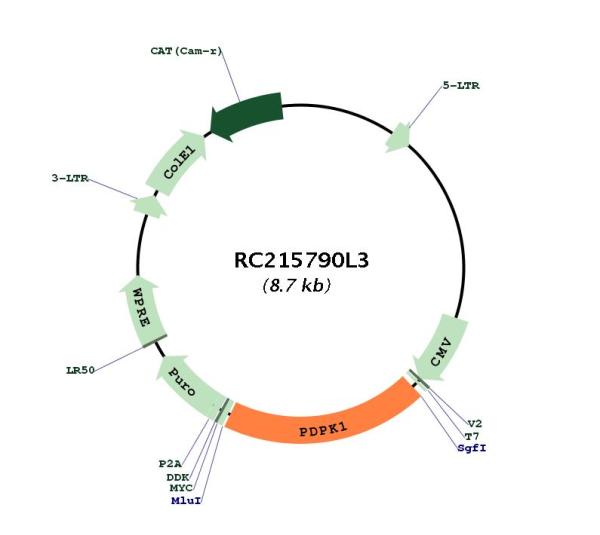PDPK1 (NM_002613) Human Tagged Lenti ORF Clone
CAT#: RC215790L3
- LentiORF®
Lenti ORF clone of Human 3-phosphoinositide dependent protein kinase-1 (PDPK1), transcript variant 1, Myc-DDK-tagged
"NM_002613" in other vectors (6)
Specifications
| Product Data | |
| Type | Human Tagged ORF Clone |
| Tag | Myc-DDK |
| Symbol | PDPK1 |
| Synonyms | PDK1; PDPK2; PDPK2P; PRO0461 |
| Vector | pLenti-C-Myc-DDK-P2A-Puro |
| E. coli Selection | Chloramphenicol (34 ug/mL) |
| Mammalian Cell Selection | Puromycin |
| Sequence Data |
The ORF insert of this clone is exactly the same as(RC215790).
|
| Restriction Sites |
SgfI-MluI
Cloning Scheme for this gene
Plasmid Map

|
| ACCN | NM_002613 |
| ORF Size | 1668 bp |
| OTI Disclaimer | Due to the inherent nature of this plasmid, standard methods to replicate additional amounts of DNA in E. coli are highly likely to result in mutations and/or rearrangements. Therefore, OriGene does not guarantee the capability to replicate this plasmid DNA. Additional amounts of DNA can be purchased from OriGene with batch-specific, full-sequence verification at a reduced cost. Please contact our customer care team at custsupport@origene.com or by calling 301.340.3188 option 3 for pricing and delivery. The molecular sequence of this clone aligns with the gene accession number as a point of reference only. However, individual transcript sequences of the same gene can differ through naturally occurring variations (e.g. polymorphisms), each with its own valid existence. This clone is substantially in agreement with the reference, but a complete review of all prevailing variants is recommended prior to use. More info |
| OTI Annotation | This clone was engineered to express the complete ORF with an expression tag. Expression varies depending on the nature of the gene. |
| Product Components | The ORF clone is ion-exchange column purified and shipped in a 2D barcoded Matrix tube containing 10ug of transfection-ready, dried plasmid DNA (reconstitute with 100 ul of water). |
| Reconstitution | 1. Centrifuge at 5,000xg for 5min. 2. Carefully open the tube and add 100ul of sterile water to dissolve the DNA. 3. Close the tube and incubate for 10 minutes at room temperature. 4. Briefly vortex the tube and then do a quick spin (less than 5000xg) to concentrate the liquid at the bottom. 5. Store the suspended plasmid at -20°C. The DNA is stable for at least one year from date of shipping when stored at -20°C. |
| Reference Data | |
| RefSeq | NM_002613.3 |
| RefSeq Size | 7254 bp |
| RefSeq ORF | 1671 bp |
| Locus ID | 5170 |
| UniProt ID | O15530 |
| Cytogenetics | 16p13.3 |
| Domains | pkinase, TyrKc, S_TKc |
| Protein Families | Druggable Genome, Protein Kinase |
| Protein Pathways | Endometrial cancer, Focal adhesion, Insulin signaling pathway, mTOR signaling pathway, Non-small cell lung cancer, PPAR signaling pathway, Prostate cancer |
| MW | 63 kDa |
| Gene Summary | Serine/threonine kinase which acts as a master kinase, phosphorylating and activating a subgroup of the AGC family of protein kinases. Its targets include: protein kinase B (PKB/AKT1, PKB/AKT2, PKB/AKT3), p70 ribosomal protein S6 kinase (RPS6KB1), p90 ribosomal protein S6 kinase (RPS6KA1, RPS6KA2 and RPS6KA3), cyclic AMP-dependent protein kinase (PRKACA), protein kinase C (PRKCD and PRKCZ), serum and glucocorticoid-inducible kinase (SGK1, SGK2 and SGK3), p21-activated kinase-1 (PAK1), protein kinase PKN (PKN1 and PKN2). Plays a central role in the transduction of signals from insulin by providing the activating phosphorylation to PKB/AKT1, thus propagating the signal to downstream targets controlling cell proliferation and survival, as well as glucose and amino acid uptake and storage. Negatively regulates the TGF-beta-induced signaling by: modulating the association of SMAD3 and SMAD7 with TGF-beta receptor, phosphorylating SMAD2, SMAD3, SMAD4 and SMAD7, preventing the nuclear translocation of SMAD3 and SMAD4 and the translocation of SMAD7 from the nucleus to the cytoplasm in response to TGF-beta. Activates PPARG transcriptional activity and promotes adipocyte differentiation. Activates the NF-kappa-B pathway via phosphorylation of IKKB. The tyrosine phosphorylated form is crucial for the regulation of focal adhesions by angiotensin II. Controls proliferation, survival, and growth of developing pancreatic cells. Participates in the regulation of Ca(2+) entry and Ca(2+)-activated K(+) channels of mast cells. Essential for the motility of vascular endothelial cells (ECs) and is involved in the regulation of their chemotaxis. Plays a critical role in cardiac homeostasis by serving as a dual effector for cell survival and beta-adrenergic response. Plays an important role during thymocyte development by regulating the expression of key nutrient receptors on the surface of pre-T cells and mediating Notch-induced cell growth and proliferative responses. Provides negative feedback inhibition to toll-like receptor-mediated NF-kappa-B activation in macrophages. Isoform 3 is catalytically inactive.[UniProtKB/Swiss-Prot Function] |
Documents
| Product Manuals |
| FAQs |
| SDS |
Resources
Other Versions
| SKU | Description | Size | Price |
|---|---|---|---|
| RC215790 | PDPK1 (Myc-DDK-tagged)-Human 3-phosphoinositide dependent protein kinase-1 (PDPK1), transcript variant 1 |
USD 776.00 |
|
| RC215790L1 | Lenti ORF clone of Human 3-phosphoinositide dependent protein kinase-1 (PDPK1), transcript variant 1, Myc-DDK-tagged |
USD 1,076.00 |
|
| RC215790L2 | Lenti ORF clone of Human 3-phosphoinositide dependent protein kinase-1 (PDPK1), transcript variant 1, mGFP tagged |
USD 1,076.00 |
|
| RC215790L4 | Lenti ORF clone of Human 3-phosphoinositide dependent protein kinase-1 (PDPK1), transcript variant 1, mGFP tagged |
USD 1,076.00 |
|
| RG215790 | PDPK1 (tGFP-tagged) - Human 3-phosphoinositide dependent protein kinase-1 (PDPK1), transcript variant 1 |
USD 976.00 |
|
| SC118544 | PDPK1 (untagged)-Human 3-phosphoinositide dependent protein kinase-1 (PDPK1), transcript variant 1 |
USD 778.00 |
{0} Product Review(s)
Be the first one to submit a review






























































































































































































































































 Germany
Germany
 Japan
Japan
 United Kingdom
United Kingdom
 China
China


